Flexible production for the factory of the future
The ability to quickly reconfigure production systems is increasingly an economic necessity. This can be achieved using software-defined manufacturing (SDM), as demonstrated by a team from Bosch Research in a publicly funded project.
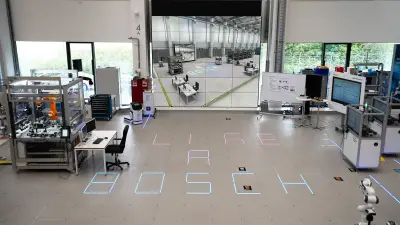
There is a consensus at factories today. At least when it comes to the design of production machines, many of which are developed specifically for one single new product and can only be modified at great expense. The manufacturing process, control software, and machine frame are tightly coupled. In times of volatile markets and short product lifecycles, this is outdated and costs money. One approach for economical production in the factory of the future is software-defined manufacturing, or SDM for short. “The idea behind it is to separate production applications from hardware and infrastructure, similar to what you’d find on a smartphone,” says Johannes Fisel, Project Leader SDM4FZI at Bosch Research. In the case of smartphones, no changes are made to the hardware, i.e., to the phone itself. The functions, and hence the purpose for which the device is being used, are determined by the applications loaded on it. In other words, the smartphone is software-defined.
A team success
SDM basically works in the same way, though it entails a much greater degree of complexity and is done on a larger scale. Johannes Fisel worked with his colleague Benedikt Feldotto, Activity Leader “Digital Production Engineering” at Bosch Research, and a large team in applying the concept in industrial production in the “SDM4FZI — Software-defined manufacturing for the vehicle and supplier industry” project funded by the German Federal Ministry for Economic Affairs and Climate Action. Some 30 project partners, including ABB, Audi, Trumpf, and Zeiss, conducted fundamental as well as applied research in the project carried out under a broad-based consortium, with Bosch Research heading up the consortium. “In particular, the focus was on software-defined manufacturing as a way to leverage reconfigurability in the face of increasing product variability and decreasing unit volumes,” says Benedikt Feldotto, who was in charge of the “Reconfigurable production systems” work package within the scope of the project.
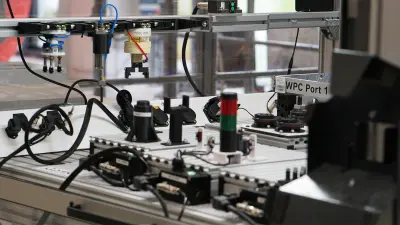
The project was kicked off in October 2021. The Bosch Research team has been working with colleagues from Bosch Connected Industry, Bosch Manufacturing Solutions, Bosch Vehicle Motion, and Bosch Rexroth for three-and-a-half years now to realize the vision of developing and operating production systems with established methods from IT.
Bosch Research focused on two key areas in the SDM4FZI project. The first was on the reconfigurability of production systems, which consist of a continuous planning process and a modular assembly station. For this purpose, a demonstrator was set up at ARENA2036 in Stuttgart, Germany. ARENA2036 is a research hub for mobility and production of the future and is part of the “Research Campus — Public-Private Partnership for Innovation” funding initiative in Germany. Virtualized control systems, with which machine controls can be transferred from the control cabinet to the edge cloud, was the second area in focus. A further demonstrator was also erected for this purpose at the research campus in Renningen near Stuttgart, Germany.
Reconfigurable production systems
Digital engineering plays a key role in the production of the future. “Our aim with digital engineering is to continuously adapt the production system to changing requirements,” says Benedikt Feldotto. Digital engineering covers the entire engineering process, from planning and design through to initial operation, with the goal of reducing the amount of time required to reconfigure the machines.
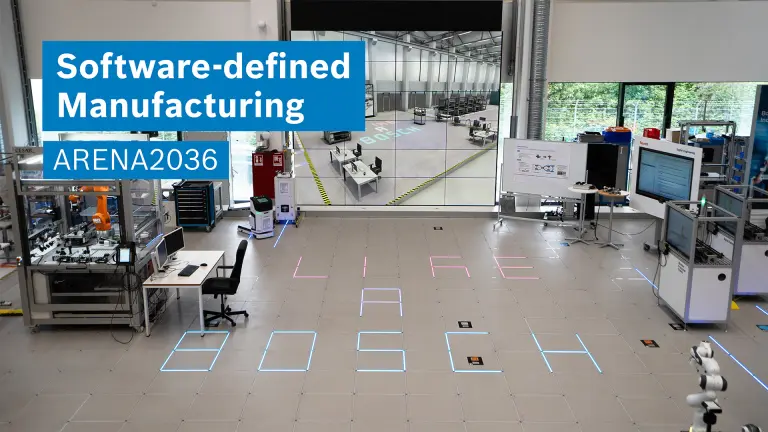
Loading the video requires your consent. If you agree by clicking on the Play icon, the video will load and data will be transmitted to Google as well as information will be accessed and stored by Google on your device. Google may be able to link these data or information with existing data.
At ARENA2036, this process was tested step by step on a segment of a steering system from the Bosch Vehicle Motion division. If, for example, a part is screwed into place in a production step, the software is programmed accordingly. If changes are to be made to the process so that the part is clipped and not screwed into place, the machine would typically have to be redesigned and modified at great expense and new control software would have to be installed and put into service. Thanks to SDM, almost everything can be done quickly and virtually. The change is planned and implemented in a digital model of the machine, i.e., its digital twin. Digital tests are then run, and adjustments made where necessary. “We are using a digital twin to test a future modular production line,” says Benedikt Feldotto. Once this step is complete, the modified software can be automatically updated on the machine. “The vision behind digital engineering is to adapt production systems more quickly and efficiently since the engineering tools are all interlinked,” explains Johannes Fisel, adding: “Beyond that, the simulation tools can also be modularly combined to cover a wide range of applications.”
To make changes to the assembly process of a machine quickly and easily, the Bosch Research team used a modular station concept that strictly separates the base station from the processes being performed. An assembly process is broken down into capabilities, which in turn are provided by a module called the mechatronic object. Depending on how these modules are arranged, they can be used to manufacture different products. Each module is equipped with its own controller and localization, making it possible to determine its position in the machine while also allowing a robot to automatically approach these modules as envisaged by the production software that is currently being run. Using this method, processes can be set up quickly without having to adapt the software or retrain robot positions. At ARENA2036, the team from Bosch Research illustrated how software-defined manufacturing can be used to achieve reconfigurable production. “The ARENA2036 ecosystem offers optimum conditions for the implementation of SDM,” says Johannes Fisel.
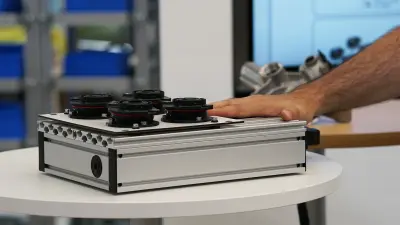
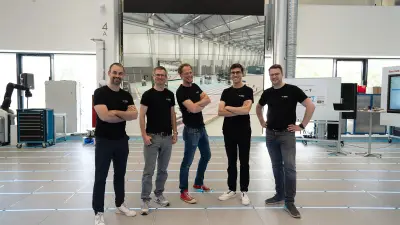
Virtualized control technology — from the control cabinet to the cloud
A demonstrator was also deployed at a test lab at Bosch’s research campus in Renningen as part of research focused on virtualized control systems. The test set-up abstracts and simplifies a manufacturing process using an inverse pendulum, that is, a pendulum with the center of gravity located above the axis. In this set-up, a metal rod is swung up and balanced in an upright position. In today’s production, the control logic for such a process is executed right in the machine. The researchers at Bosch Research succeeded in transferring this control logic from the control cabinet to an edge cloud, so to speak. Bosch Rexroth developed the prototype of the virtualized control system as part of the SDM4FZI project based on the automation solution ctrlX AUTOMATION. Based on this, Bosch Research developed the operating concept for the edge cloud outsourcing. The new concept was successfully tested in the demonstrator, also with regard to whether it can be deployed in Bosch plants. What has been achieved here on a small scale can be carried over to production in the factory of the future.
As a result, the members of the SDM4FZI research team were able to demonstrate how current control applications from the production lines can be transferred to an edge cloud and operated there. With this solution, a large number of machines can be controlled quickly, securely and centrally via software. “The keyword is virtualized control — a software-based control solution that provides the functions of a conventional, hardware-based control system in a virtualized environment on standard computer systems without having to rely on specialized hardware,” explains Patrick Wiener, Activity Leader “Industrial Edge Control” at Bosch Research.
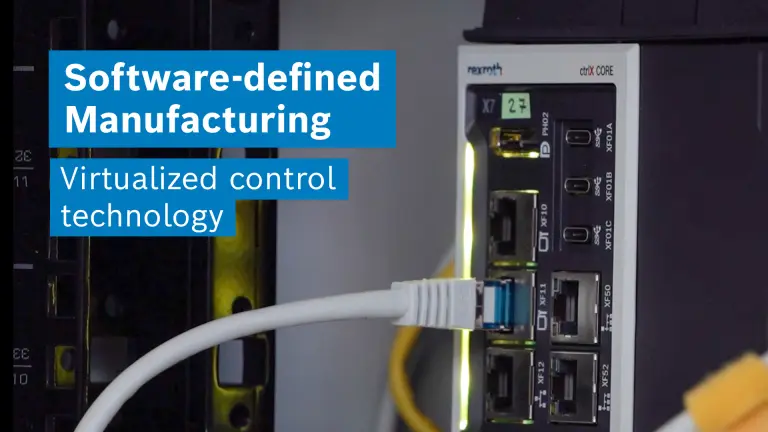
Loading the video requires your consent. If you agree by clicking on the Play icon, the video will load and data will be transmitted to Google as well as information will be accessed and stored by Google on your device. Google may be able to link these data or information with existing data.
This has a number of advantages for manufacturers. Firstly, it saves costs as the need for physical hardware in the control cabinet and the associated expenses are reduced. Secondly, it increases efficiency and flexibility on the Shopfloor, as the integration with IT mechanisms enables easier maintenance and quick adjustments to changing requirements. “For example, new virtualized control instances can be started with the push of a button,” says Patrick Wiener. Another focus of the team's research was how control applications of the future can be developed to complement the classic programming languages used in control technology.
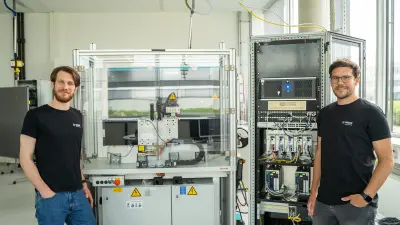
Summary
The SDM4FZI project has now been completed, with the companies who collaborated on the project having presented the results in late March 2025. Through their research, the Bosch Research Team demonstrated that SDM has great potential in industrial application. In the future, experts from Bosch Research and the various divisions at Bosch will work closely together to bring SDM applications to market and also deploy them in their own production activities.